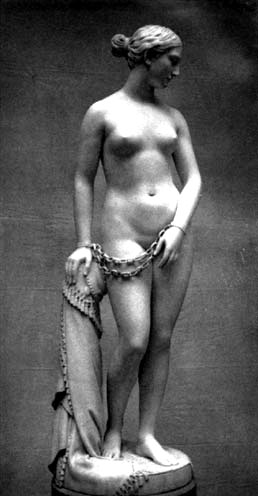
The Greek Slave
Hiram Powers (1805-1873)
Marble
Exhibted at the Great Exhibition of 1851
Related material
[Victorian Web Home —> Visual Arts —> Sculpture —> Hiram Powers —> Next]

The Greek Slave
Hiram Powers (1805-1873)
Marble
Exhibted at the Great Exhibition of 1851
Related material
Powers's Greek Slave, which was almost certainly the most famous work of sculpture in the second half of the nineteenth century, inspired the following sonnet” by one of the most popular poets of the age:
They say Ideal beauty cannot enter
The house of anguish. On the threshold stands
An alien Image with enshackled hands,
Called the Greek Slave! as if the artist meant her
(That passionless perfection which he lent her,
Shadowed not darkened where the sill expands)
To so confront man's crimes in different lands
With man's ideal sense. Pierce to the centre,
Art's fiery finger! and break up ere long
The serfdom of this world. Appeal, fair stone,
From God's pure heights of beauty against man's wrong!
Catch up in thy divine face, not alone
East griefs but west, and strike and shame the strong,
” by thunders of white silence, overthrown. — Elizabeth Barrett Browning [II, 302]
"This celebrated exhibit stood in the middle of the American Section under a specially erected canopy and background of red plush. . . . As one of the most popular exhibits in the exhibition, the figure naturally gave rise to a wealth of comment, a selection of which is here quoted. 'The Greek Slave is one of the "lions" of the Exhibition and most deservedly so.' 'One of the most exquisite objects in the museum (sic) . . . a centre of a bevy of admiring spectators.' 'In this work a youthful creature of very delicate form is represented in marble. The figure is studied from life and exhibits an extraordinary refinement of imitation. The treatment of the back, especially, is one of the happiest efforts in modern sculpture.' 'The pedestal is so arranged that the wholc figure can be turned round thereby displaying cvery portion of this chef-d'oeuvre. We recommend it to the artist, the statuary, and as the Athenaeum would say, "to the lover of the beautiful".' 'During the early Greek revolutions the captives were exposed for sale in the Turkish bazaar, under the Hiram Powers of "slaves". The artist has delineated a young girl, deprived of her clothing, standing before the licentious gaze of a wealthy Eastem barbarian. Her face expresses shame and disgust at her ignominious position, while about her lip hovers that contemptuous scorn which a woman can so well show for her unmanly oppressor.
"It is a hard thing to produce a perfect work, and many faults were soon found to injure the wellmerited reputation of the statue. The manner in which the right hand was made to lean upon the trunk of a tree, while the whole weight of the body was thrown upon the left leg was, however, the only grave error committed” by the sculptor; and the greater number of those who daily swept past this happy effort of his genius, felt disposed to reply to all the merciless critics." [The Great Exhibition, p. 129; thanks to Mark Bernstein for pointing me to the URL. — GPL]
Browning, Elizabeth Barrett. Poetical Works. 14th ed. 5 vols. London: Smith, Elder, 1886.
The Great Exhibition of 1851: A Commemorative Album. rev. ed. London: Victoria and Albert Museum, 1964. Figure 184.
Unattributed essay on the reception The Greek Slave on the Assumption College site. Viewed 10 September 2006.
Last modified 10 September 2014